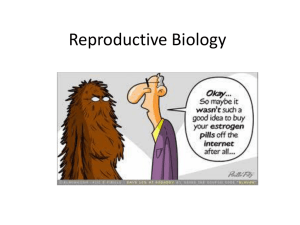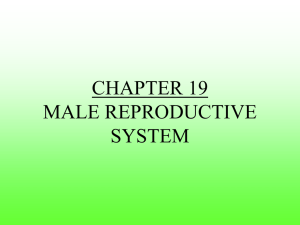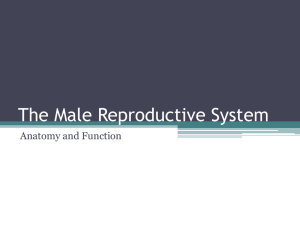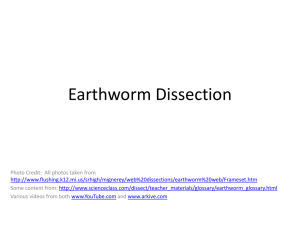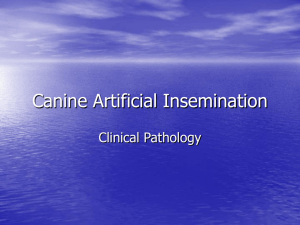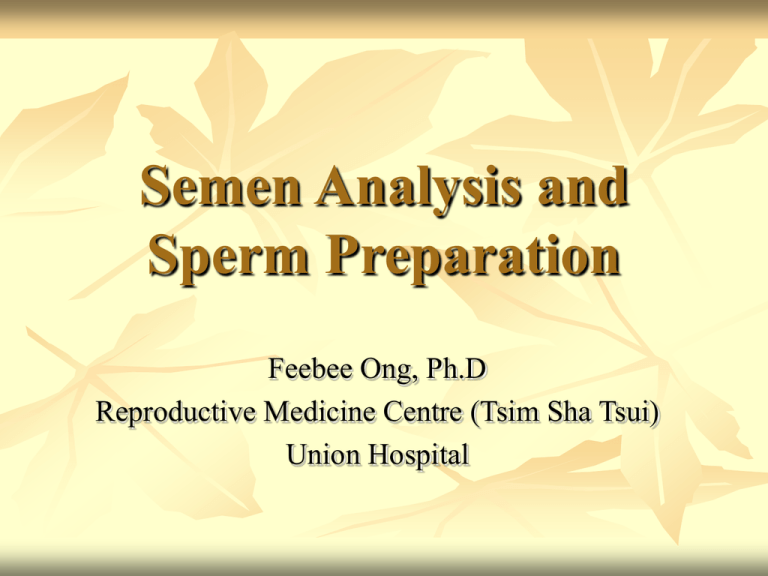
Semen Analysis and
Sperm Preparation
Feebee Ong, Ph.D
Reproductive Medicine Centre (Tsim Sha Tsui)
Union Hospital
Semen Analysis
SA are mainly carried out to determine whether:A man has a reproductive problem that is causing infertility.
A vasectomy or vasectomy reversal has been successful
SA is the singular test for fertility in male that can provide
information on
sperm production.
patency of the male ducts.
the function of the accessory glands.
and ejaculative function.
Since semen samples may vary from day to day, 2 or 3 samples may
be evaluated within a 3-6 month period for accurate testing.
A semen analysis to test the effectiveness of a vasectomy is usually
done 6 weeks after the vasectomy
Semen Analysis
Semen analysis is a relatively inexpensive test to perform
in Hong Kong. But because it is inexpensive and simple,
many doctors and patients believe it is an easy test to
perform.
In reality, it is a test that requires skill and expertise. It is
easy to perform the test badly as it is subjective.
Besides containing sperms, normal semen also contains
water, simple sugars such as fructose for nourishment of
sperms and alkaline substances that buffer sperms against
acidic environment in the vagina. Semen also contains
prostaglandin which can cause contractions in the uterine
muscles, vitamin C, zinc, cholesterol and a few additional
compounds which may also be tested
Human Semen
Semen can be divided into 4 fractions:
1. Pre-ejaculatory –secretion from urethral and
bulbourethral gland (no sperms)
2. Dilute fluid from prostate gland (no sperms)
3. Major portion of sperms from vas deferens and distal
epididymis (volume 5%)
4. Seminal vesicle secretion (few sperms)
Fraction 1, 2, 3 made up of the first portion of the
ejaculate (30% of total volume). Therefore important to
ensure the first portion is collected.
IMPORTANT – Mix semen well before analysis
Ways to Collect Semen
Masturbation, directing the semen into a clean sample cup.
Do not use a lubricant which can kill sperms
Coitus interruptus - withdrawing the penis from the partner
just before ejaculating follow by ejaculating into a clean
sample cup.
Coitus - by using a condom. A special (silicon) condom
that does not contain any substance that kills sperm
(spermicide). After ejaculation, carefully remove the
condom from the penis. Tie a knot in the open end of the
condom and place it in a container that can be sealed in
case the condom leaks or breaks. Ordinary condoms
should not be used since they usually contain spermicides
Assisted ejaculation – electro-ejaculation used in
paralegics
Semen Collection
Good and reliable SA results starts from semen collection,
preferably by masturbation
•
Abstinence days 2-6
•
Pass urine
•
Wash hands with soap, dry
•
Collect the entire sample into
the wide mouth sterile
container, 70% of sperms is
in the first part of the
ejaculate
•
Keep the sample at body
temperature, no sunlight
•
Deliver the sample within
one hour of ejaculation
WHO 2010
Fifth edition (30 years from 1st edition, 1980)
Reference range is derived from 4500 SA characterizing
semen quality of fertile men whose partner had time to
pregnancy of 12 months or less
Raw data on from recent fathers in 14 countries on four
continents. Chinese data on 429 SA and 4 Singaporean SA
was included. No Indians and other Asian nationalities.
The 5th percentile is given as the lower reference range
No high value reference range is given as it is not considered
detrimental to fertility
Ref : Cooper TG et al. Human Reproduction Update, Vol.16,
No.3 pp. 231–245, 2010
The WHO 2010 criteria is a guideline to improve semen analysis
and sperm preparation, not obligatory
WHO 2010
Parameter
Semen volume (ml)
Lower Reference Limit
1.5
Sperm concentration (106/ml)
Total sperm number (106/ejaculate)
Progressive motility (PR, %)
Total motility (PR +NP, %)
15
39
32
40
Vitality (live sperms, %)
Sperm morphology (NF, %)
pH*
58
4
>/=7.2
Leucocyte* (106/ml)
MAR/Immunobead test* (%)
*Parameters agreed on consensus
<1
<50
Terminologies of SA
Oligospermia – sperm concentration <15 million/ml
Asthenozoospermia – <40% grade (PR+NP) or < 32 PR%
Teratozoospermia – <4% spermatozoa
OAT =Oligo-astheno-teratozoospermia
Azoospermia – no spermatozoa in semen
Polyzoospermia – ++ high sperm concentration, >200M/ml
Hypospermia – semen volume < 1.5 ml
Hyperspermia – semen volume > 6.0 ml
Aspermia – no semen volume
Pyospermia – leukocytes present in semen, >1M/ml
Hematospermia – red blood cell present in semen
Necrozoospermia – “dead” sperm
Macroscopic Examination
WHO criteria 2010
Appearance
Normal:
Description
Whitish to grey opalescent
Yellow (urine, jaundice); Pink/Reddish/Brown (RBCs)
Liquefaction Normal:
15–30 minutes after collection
Lumpy >60 min – sperms may be trapped in unliquefied jelly;
maybe sign of prostatic infection, lack of prostatic protease
Viscosity
Normal
Smooth and watery
Abnormal –, thick with long threads (21G needle). High
viscosity impede sperm movements
MIX SEMEN THOROUGHLY BEFORE ANALYSIS –USE A
PIPETTE
Macroscopic Examination
Volume
Normal:
1.5 ml per ejaculation
Low volume (<1ml) reflect a problem with the seminal vesicles
and prostate – a block, retrograde ejaculation, infection or lack
of androgen.
Low semen volume cannot neutralize vaginal acidity
High semen volume dilute sperms/ active infection
pH
Normal:
=/>7.2 (alkaline)
Acidic pH (<7.0) in a low volume & density sample indicates –
congenital bilateral absence of vas deferens (in which seminal
vesicles are also poorly developed) and ejaculatory duct
obstruction. pH increases with time as natural buffering capacity
of semen decreases – therefore high ph is not clinically useful
Sperm Motility Assessment
A very important parameter
Glass slide and coverslip 22 x 22mm
Add 10ul semen
Area = 484mm2, depth 20.7um
Wait 1-2 minutes before reading, use 40x magnification
Count 200 sperms in total from several fields
Count only complete sperms, not pinheads
PR=Progressive motility (forward movement, large circles)
NP=Non progressive (on the spot movement, twitching)
IM=immotile (no movement)
Sperm Density Assessment
Add 10 ul semen to 190 ul
water = 20x dilution.
Mix well
Add 10 ul of mixture to the
chamber
Wait 2-3 min to settle
Sum of 5 squares (central
grid) = sperm density x 106/ml
Count only whole sperms, not
pinheads
Read at x20 objective
Use the “L” rule
Neubauer haemocytometer
chamber is the WHO 2010
recommended standard
Sperm Density Calculation
With chamber depth of 100um, each large grid holds 100nl.
The central grid contains 5 x 5 squares = 25 squares = 4nl
per square
Count = Number of sperms / volume x dilution factor
Example : N (per 5 squares) x 20 (DF) = C x 106 sperms per ml
(1+19)
20 nl
Example: N (per 5 squares) x 5 (DF) = C x 106 sperms per ml
(1+4)
20nl
4
*1 ml = 1x106 nanolitre
(At 20x objective~16nl, at 40x objective ~4nl)
Makler Chamber
A 10 ul of semen
Allow 1 minute to settle and
spread evenly.
Use x20 objective.
A row of 10 squares = sperm
density x 106/ml.
Read motility and sperm
density at the same time
Usually 3 to 5 randomly
selected rows are read.
If < 5 sperms per row of 10
squares is seen, then the entire
grid is counted.
A chamber specially designed
for semen analysis
Azoospermia
In cases of very low sperm count – perform sperm count
using a lower dilution factor example 1+4
In cases of azoospermia, concentrate entire semen
volume into a small pellet, spread the pellet onto a glass
slide and observe again.
Use the “SS” pattern
IMPORTANT –Repeat SA for confirmation
Vitality Assessment
1.
2.
3.
4.
Eosin-nigrosin (dead sperm stain pink/red)
Eosin (1%) (dead sperm stain pink/red)
Trypan (0.4%) blue (dead sperm stain blue)
Hypo-osmotic swelling test (HOS) (live sperm shows tail
curling
Test 1, 2 and 3 for diagnostic uses.
Usually 1:1 ratio of semen to dye mixture, mix well and
smear onto a slide. Read immediately at x40 objective,
count 200 sperms
Test 4 is use to choose live (immotile) sperm for ICSI
Dead sperms will not react in HOS while live sperm will
take up fluids causing their tails to curl within 5 min and
stabilize at 30 min. Therefore viable sperms may be
selected for ICSI [Lin et al, 1998; Cayan et al, 2001].
Vitality Assessment
Dead sperms are stained pink/red
Live sperms shows curling tails
Morphology by Strict
Sperms must be stained for an accurate assessment
Strict criteria /Kruger /Tygerberg
The sperm head is oval, smooth-symmetrical outline, a length
of 3-5 um and a width of 2-3um.
The head should have a well defined acrosome area of 40-70%
and vacuoles (=/<2) that occupies ~ 20% head area.
The mid-piece must be straight and slender, 0.5 um in width
and 7-8um long, straightly aligned to the head.
The tail must be straight and 45-50 um long.
To be classified as normal, the sperm must be normal in all
portions (head, mid-piece, tail).
At least 400 sperms must be scored on randomly chosen fields.
Normal Forms (%) = normal sperms / the total number of
sperms evaluated x 100.
Hematoxylin-Eosin Staining
o
o
o
o
o
o
o
o
o
o
o
o
Hematoxylin-Eosin
Fix slide in EtOH/MeOH 95%
Wash in running tap water
Dry on absorbent paper
Hematoxylin (Sigma, HHS128)
Wash in running tap water
Acid alcohol (99 ml 70%
EtOH + 1 ml H2SO4)
Eosin (Sigma, HT1102128)
EtOH 70%
EtOH 90%
Absolute EtOH (99.9%)
Xylene
20 min
5 min
20 min
5 min
Dip (2)
5 min
2 min
2 min (2)
2 min (2)
2 min (2)
Fairly good
differentiation
The acrosomal area
and cytoplasmic
fragments is stained
pink and the postacrosomal area is
stained dark purple.
Abnormally stained
sperms (nuclear/
chromatin material)
may be
differentiated.
Takes longer and
need experience to
produce good
staining
Diff-Quik Staining
Diff-Quik Staining (Baxter, Australia)
Simple, quick staining method.
Moderate differentiation of structures --the acrosome is stained
red and the post acrosomal area dark red. Very thin smears are
necessary as the background is influenced by the presence of
protein in the seminal fluid and tends to be dark.
The slides are fixed with fixative (Cytospray, Kinetik, Australia).
Diff Quik 1 for 5-6 seconds.
Clean water x 2. Removed excess moisture.
Diff Quik 2 for 10 seconds
2-3 dips in clean water.
It is left to dry by standing the slide on one end on absorbent
paper towel.
Sperms stained by Diff-Quik are larger by comparison to H&E
staining as the cells did not undergo dehydration by alcohol.
Abnormal Sperms
Abnormal Sperms
1. Triple head
sperm
2. Acrosome
reacted
sperm
3. Sperm with
no acrosome
4. Sperm with
a tapering
head and
swollen
mid-piece
Morphology Assessment
Assessment is subjective due to
the wide variation in sperm sizes
and shapes.
% NF correlated well with the
fertilization rate in-vitro and
pregnancy rate [Kruger et al,
1996; Morgenthaler et al, 1995]
Sperms with defective heads are
more likely to be immotile than
sperms without defects, and
defective motile sperms tend to
show sluggish motility as
compared to normal sperms
[Aitken et al, 1995].
Round Cells Assessment
Round cell concentration can be assessed from slides. If 400
sperms are counted and the number of round cells are N and
sperm concentration is S. Then the formula for concentration
(C) of round cells (x106 per ml) :C = N/400 x S
Only Neutrophils are stained by peroxidase, other WBCs such
as lymphocytes and macrophages, epithelial cells as well as
spermatogenic cells remain unstained.
The presence of neutrophils (multi-lobated nuclei) denotes
infection/inflammatory reaction
Human Reproduction Update 2000. Johanisson E et al
Mixed Anti-globulin Reaction Test
Place 10 ul of semen, SpermMar latex particles and antiserum
on a glass slide.
Mix well semen and latex particles (5 seconds), followed by
the antiserum (5 seconds).
Place a coverslip on top of the mixture and incubate the slide
at RT for 2-3 minutes in a damp chamber (e.g. a Petri dish
with a moist cotton or filter paper)
Count at least 200 sperms.
Assume clinical significance (infertility due to immune
reaction ) if >50% of sperms have beads attached.
Latex beads
antiserum
semen
Glass slide
Computer Assisted SA (CASA)
Advantages
More objective and reproducible measurement
Superior documentation of laboratory values
Superior in measurement of sperm motility
Disadvantages
Not reliable if sperm density is <2x106/ml or >50x106/ml,
lots of debris/immotile sperm. Require dilution if >40 x
106/ml in isotonic buffer to avoid sperm collision
Need to record 200 sperms for accurate distribution of
velocity.
Parameters not standardized between laboratories –
difficult to interpret results
No improvement on the manual method in distinguishing
fertilizing capacity of semen
Computer Assisted SA (CASA)
Uses video and computer software technology to capture the
types and speed of sperm motility.
Automatic image digitization and processing
Additional parameters can be measured such as curvilinear
velocity (VCL) , straightline velocity (VSL), linearity and
flagellar beat frequency and amplitude of lateral head (ALH)
VCL=mean distance btw 1st sperm- 2nd sperm position/time
VSL=distance btw 1st –last sperm position/time
VAP=average path velocity
ALH =mean deviation from average path
LIN =linearity (VSL/VCL)
STR=straightness (VSL/VAP)
CASA and SQA-V
Twelve fresh semen samples from fertile volunteers and 73 from infertility
patients were compared for sperm concentration and motility, sperm
motility index (SMI), amplitude of lateral head displacement (ALH), beat
cross frequency (BCF), curvilinear velocity (VCL), straight line velocity
(VSL), average path velocity (VAP), linearity (LIN = VSL/VCL) and
straightness (STR = VSL/VAP).
Significant differences were observed in the above parameters between the
fertile and infertile groups. An obvious consistency was noted between the
results from SQA-V and those from CASA in sperm concentration (r = 0.58,
P < 0.01), motile sperm concentration (r = 0.75, P < 0.01) and average
sperm velocity (r = 0.59, P < 0.01). Significant correlations were found
between the SMI from SQA-V and STR, LIN, BCF, VCL, VSL and VAP
from CASA (P < 0.05).
There is a consistency between the results from SQA-V and those from
CASA. Both the devices can detect the seminal differences between
different cohorts of patients
Zhong Nan Ke Xue 2008 by Ge YF et al
CASA for Research
This study was conducted in Calcutta, India, - a selected group of subjects,
designated as normozoospermic in routine analysis, but under risk factor
exposure, were selected for a repeat computer aided semen analysis (CASA)
and were compared with a control group. The parameters considered
among CASA results were: curvilinear velocity (VCL), straight-line
velocity, average path velocity (VAP), straightness index (STR), lateral
head displacement (ALH) and beat cross frequency. The results depict a
significant decline in the mean values of VCL (P = 0.029) and STR (P =
0.007) in the tobacco-exposed group when compared with the unexposed
group. On the other hand, there was a significant decline in the mean values
of VCL (P = 0.014) and ALH (P = 0.040) in the heavy metal-exposed group
when compared with the unexposed group. The other parameters did not
show significant change in either group. Semen samples that had been
designated normozoospermic in conventional analysis were seen to be
influenced by risk factors at the level of sperm motion kinetics.
Andrologia 2010 by Mukhopadhyay D et al
Retrograde Ejaculation
Retrograde ejaculation occur whereby the semen is ejaculated into the
bladder. The acidity of the urine will kill sperms quickly. Alkalination
of the urine is very important in order to recover live motile sperms.
The patient is instructed to alkalinize his urine by intake of sodium
bicarbonate, 3g (two table spoons) dissolved in a glass of water in the
evening before bed.In the morning, the patient must empty his
bladder completely and drink another glass of sodium bicarbonate
before coming directly to the laboratory.
Ask the patient to empty his bladder before semen collection. Provide
two containers for collection, a small one for semen and a larger one
for urine. Instruct the patient to collect the semen by masturbation and
to urinate immediately after masturbation.
The urine is divided into tubes and centrifuged for 10 min at 1500
rpm.
The supernatant is removed leaving behind the pellet. The contents of
all tubes are pooled.
Analyzed as SA
Add 2-3 ml of culture medium before proceeding with a gradient
column.
Transient Poor SA
Poor SA can result from factors such as:•
•
•
•
•
Incorrect semen collection technique – spillage, dirty
container, long delay in delivering sample
Poor technical expertise
History of recent illness – flu or high fever may depress
sperm counts
Long period of abstinence – increased abnormal sperm
morphology and decrease motility
Short abstinence period – lower semen volume and sperm
count
As it take 10 weeks (64-70 days) for a new batch of sperm to be
generated by the testes, it is best to repeat SA after a period
Factors affecting SA results
Medicines, such as cimetidine (Tagamet), male and female
hormones (testosterone,estrogen), sulfasalazine,
nitrofurantoin, and some chemotherapy medicines.
Caffeine, alcohol, cocaine, marijuana, and smoking tobacco.
Herbal medicines, such as St. John's wort and high doses of
echinacea.
Temperature - sperm motility value will be inaccurately low
if the semen sample gets cold.
Exposure to radiation, some chemicals (such as certain
pesticides or spermicides), and prolonged heat exposure.
An incomplete semen sample -- more common if a sample is
collected by methods other than masturbation.
Not ejaculating for several days -- affect the semen volume
Conditions with Abnormal SA
Certain conditions may be linked with a low or absent
sperm count. These conditions include:
Orchitis
Varicocele
Klinefelter syndrome
Radiation treatment to the testicles
Diseases that can cause shrinking (atrophy) of the testicles
(such as mumps).
Long term illness such as diabetes which may cause
retrograde ejaculation
Hormonal imbalance (testosterone, luteinizing hormone
(LH), follicle-stimulating hormone (FSH), or prolactin
Azoospermia - A small sample (biopsy) of the testicles may
be needed for further evaluation.
Improving SA
Quality Assurance Program
Standard Operating Procedures
Laboratory Manual
Documentation
Sample ID and Tracking
External QC
Comparison of tests with an external source
Internal QC
Minimized variation by training
Purchased QC samples with known values
Video recordings for motility
Sperm preparation
The semen is a mixture of motile and dead spermatozoa with
cells, cellular debris and sometimes micro-organisms present.
A variety of methods have been developed to separate the
motile sperms from the ejaculate. The most common methods
are washing and centrifugation which has been shown to cause
some damage to the sperm.
Simple sperm wash
Swim up
Gradient
All preparations should done in a laminar flow for sterility
[Dale & Elder, 1997].
The clean sperm suspension is used for IUI, IVF and ICSI and
certain special sperm tests.
Simple wash
This method is used if the semen sample is very poor. It
mainly removes seminal plasma from the sperms.
One volume of semen is placed in a 15 ml test tube and diluted
with 2 volume of culture medium. The tube is gently inverted
twice to mix the components.
The tube is then centrifuged at 250-300g for 5-7 min.
The supernatant is removed and the pellet is re-suspended in 2
ml of culture medium.
The centrifugation is repeated at 250-300g for 5-7 min and the
supernatant removed. About 0.4 ml of media is added to the
final sperm pellet for re-suspension.
The sample is suited for intra-cervical insemination
Swim up method
This technique relies on the ability of the sperms to swim. This
method is suitable for semen with high to moderate motility.
Semen is diluted with 1:2 ratio of culture medium and
centrifuged at 250-300g for 5-7 min.
The supernatant is removed leaving the pellet.
Pipette 0.8-1 ml of media into a new test tube. Carefully layer
the semen pellet beneath the media.
Stand at 37o for 45-60 min. Placement of tube at 45oangle
creates a larger surface area for sperms to swim-up.
Carefully take up the top 0.5-0.6 ml without disturbing the lower
layer and transfer into a new test tube.
To concentrate the sperms, pooled several tubes and centrifuged
at 250-300g for 5-7 min. The supernatant is removed and the
resultant pellet re-suspended in 0.4 ml of media.
Gradient systems
Gradient systems use solutions with a higher density than
semen to separate the debris, cells, micro-organisms and
non-motile sperms from the motile ones.
Among the dense solutions used are colloidal silica (Percoll,
Puresperm), poly-sucrose (Ficoll, Ixaprep) and other dense
solutions (Optiprep, Nycodenz).
All could be obtained commercially
Centrifugal force is applied to enable the motile sperms to
swim from a less dense seminal fluid into a denser solution.
Cellular debris and non-motile microorganisms will be
trapped at the interphase between the two solutions
Select more normal sperms than swim up method.
Recovery may be poor in viscous semen and severe
teratozoospermia (small heads but good swimmers)
Gradient tubes preparation
semen
semen
40%
40%
70%
80%
90%
2 gradient column
Density gradients must be
prepared just before usage,
gradients will mixed after
standing for an hour or so.
The volume of semen being
processed should not exceed
the volume of the gradient in
order to get a good recovery.
A mini gradient column
If a large volume of semen is placed on top of the column, seminal fluid will mix
with the gradients due to its weight.
A prior concentration step to reduce seminal volume can be carried out
(centrifugation at 350g for 5-7 min) if the initial volume was high. This will
reduce the number of gradient column necessary for semen processing.
However, centrifugation should be kept to a minimum as it has been shown to
induce sub-lethal damage in sperms.
Two Gradient Column
Usually comprise 2ml of each solution i.e. 40% and 80%
Gently pipette 80% solution followed by 40% solution in a 15
ml test tube. Two visible layers should be seen.
Layer 2-4 ml of semen on top of the column.
Centrifuge for 10 min at 600g to assists the sperms in reaching
the bottom layer.
All supernatant is removed leaving the sperm pellet.
The pellet is transferred to a new tube and resuspended in 3.0 ml
of media.
The tube is centrifuged again for 5-7 min at 250g in order to
remove the silica particles found in gradient solutions.
Remove all supernatant leaving the pellet and resuspend it with
0.4 ml of media.
This method can be used to harvest motile sperms from poor
quality samples. Usually a two gradient column is adequate for
the processing of most semen samples.
Mini gradient procedure
A three gradient column is used to remove
the cryopreservatives from thawed semen
Density
samples
(%)
1 ml each of 40%, 70% and 90% is used.
Overlay 2-3 ml of semen onto each gradient
40
column
70
Centrifuge the tubes at 600g for 10 minutes
to assist the sperms in reaching bottom.
90
All supernatant is removed leaving the sperm
pellet. The contents of several tubes may be
pooled.
The pellet is transferred to a a new tube and
resuspended in 3.0 ml of media. The tube is
centrifuged again for 5-7 min at 250g in
order to remove the silica particles
Remove all supernatant leaving the pellet and
resuspend it with 0.4 ml of media.
Stock
solution
(ml)
Media
(ml)
2.0
3.0
3.5
1.5
4.5
0.5
10
5.0
FOR IVF/ICSI, a swim up is performed after gradient processing
References
WHO 2010 laboratory manual for the
Examination and processing of human semen


